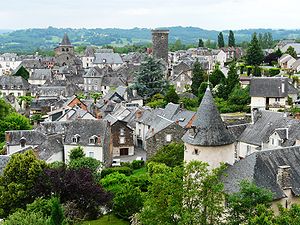Allassac
|
Allassac Alaçac |
||
|---|---|---|

|
|
|
| region | Nouvelle-Aquitaine | |
| Department | Corrèze | |
| Arrondissement | Brive-la-Gaillarde | |
| Canton | Allassac (main town) | |
| Community association | Bassin de Brive | |
| Coordinates | 45 ° 16 ′ N , 1 ° 29 ′ E | |
| height | 103-387 m | |
| surface | 39.01 km 2 | |
| Residents | 3,903 (January 1, 2017) | |
| Population density | 100 inhabitants / km 2 | |
| Post Code | 19240 | |
| INSEE code | 19005 | |
| Website | www.allassac-correze.com | |
 View over the city |
||
Allassac ( Occitan Alaçac ) is a French commune in the Corrèze department on the western edge of the Massif Central . The municipality is a member of the Communauté d'agglomération du Bassin de Brive . The inhabitants call themselves Allassacois (es) .
geography
Tulle , the prefecture of the department, is located about 35 kilometers to the east, Brive-la-Gaillarde about 15 kilometers to the southeast and Uzerche about 29 kilometers to the northeast. Located in the Brive basin, the city and its entire territory are defined by three rivers: the Vézère , a right tributary of the Dordogne , the Loyre , a right tributary of the Vézère and the Clan , an indirect tributary of the Corrèze .
Neighboring communities
Neighboring municipalities of Allassac are Estivaux in the north, Saint-Bonnet-l'Enfantier in the northeast, Sadroc and Donzenac in the east, Saint-Viance , Varetz and Yssandon in the south, Jugeals-Nazareth in the southwest and Saint-Aulaire , Objat and Voutezac in the west.
traffic
Junction 48 for Autoroute A20 is about five kilometers to the south-east. In the center of the village is the train station, which is a stop on the Orléans - Montauban line .
history
Finds from the Mesolithic indicate a long history of settlement in the area. Founded between the 1st and 3rd centuries AD, the name comes etymologically from the Gallic- Roman language area, evidenced by the suffix -acum , in Occitan it became ac and denotes a place or farm or an estate. So Allassac would mean Alacius's estate . Several slate quarries for the production of slate shingles enabled a rapid economic boom in the city. The place was first mentioned in the will of Aredius of Limoges and was then called Alaciaco in 947 . In the Middle Ages , the city became a fiefdom of the Abbey of Saint-Martial in Limoges , after which it became a fiefdom of the Roffignac family, among others . Later in the 14th century, the place was surrounded with a second fortification wall, which included 17 towers, 8 gates and 6 castles. Allassac experienced steady growth during the 16th and 17th centuries, driven primarily by the production of slate shingles and cured products. Another mainstay of the economy was viticulture, but this came to a complete standstill when phylloxera appeared at the end of the 19th century. The last slate quarries closed in 1997, but have experienced a renaissance since 2006.
coat of arms
Description : Divided into black and silver and split into gold. In front a red-tongued golden eagle with golden shamrocks on the wings over a three-legged red tournament collar and behind a red upright lion .
Population development
| year | 1962 | 1968 | 1975 | 1982 | 1990 | 1999 | 2006 | 2017 |
| Residents | 3619 | 3448 | 3474 | 3532 | 3379 | 3366 | 3601 | 3907 |
economy
Today Allassac is predominantly agricultural (fruit growing and cattle breeding ( Limousin cattle )). The place was famous for its wines until the 19th century, but today an area of five hectares on slate is replanted with vines.
Attractions
- The Tour de César , a defense tower from the 12th and 14th centuries, has been classified as a Monument historique since August 22, 1949 .
- The manor , known as the old school of the towers (ancienne École des Tours), a secular building from the 15th and 16th centuries, has been classified as a monument historique since 23 August 1993 .
- The Saillant Bridge , a 16th century bridge over the Vézère, has been classified as a Monument historique since March 22, 1933 .
- The Église de la Décollation de Saint-Jean-Baptiste (Church of the Beheading of John the Baptist), a sacred building from the 12th and 14th centuries, has been classified as a Monument historique since October 24, 1914 .
Personalities
- Raynaud de la Porte (1260-1325), Archbishop of Bourges and Cardinal of Ostia
- Georges Mamy (1921–1997), French journalist and writer
Web links
Individual evidence
- ↑ Historique ( Memento from December 23, 2015 in the Internet Archive )
- ↑ http://www.ardoisieresdecorreze.com/index.php?page=carriere
- ↑ LES ARDOISIERES: UNE RENAISSANCE APRES 30 ANNEES DE SOMMEIL ( Memento of November 27, 2015 in the Internet Archive )
- ↑ Entry no. PA00099648 in the Base Mérimée of the French Ministry of Culture (French)
- ↑ Entry no. PA00125504 in the Base Mérimée of the French Ministry of Culture (French)
- ↑ Entry no. PA00099647 in the Base Mérimée of the French Ministry of Culture (French)
- ↑ Entry no. PA00099646 in the Base Mérimée of the French Ministry of Culture (French)





